

Oxygen Sensor Removal/Installation
Refer to the Oxygen Sensor Removal/Installation (Equipped Models) in the Electrical System chapter.
Oxygen Sensor Inspection

Main Harness [B] Oxygen Sensor [C]
Special Tool - Measuring Adapter: 57001-1700
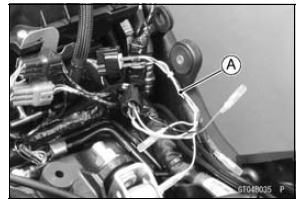
Oxygen Sensor Output Voltage Connections to Adapter: Digital Meter (+) → R (sensor BK) lead Digital Meter (–) → BK (sensor GY) lead
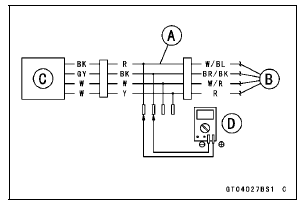
Do not disconnect the air switching valve connector [B].
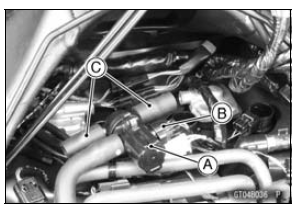
Air Cleaner Housing (see Air Cleaner Housing Installation in the Fuel System (DFI) chapter) Fuel Tank (see Fuel Tank Installation in the Fuel System (DFI) chapter)

Measuring Adapter [A]
Output Voltage (with Plugs, Rich) Standard: DC 0.8 V or more
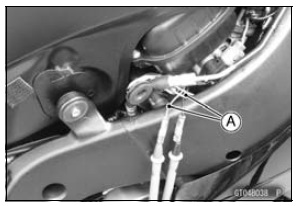
| WARNING The engine gets extremely hot during normal operation and can cause serious burns. Never touch a hot engine. |
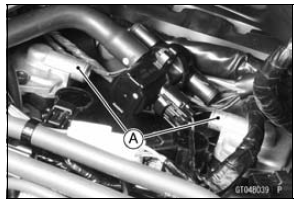
Air Cleaner Housing (see Air Cleaner Housing Installation in the Fuel System (DFI) chapter) Fuel Tank (see Fuel Tank Installation in the Fuel System (DFI) chapter)
Output Voltage (without Plugs, Lean) Standard: DC 0.24 V or less
If the reading is out of the standard (with plugs: 0.8 V or more, without plugs: 0.24 V or less), remove the ECU and check the wiring for continuity between harness connectors.
Special Tool - Hand Tester: 57001-1394

Disconnect the ECU and sensor connectors.
Wiring Continuity Inspection ECU Connector [A] ←→ Oxygen Sensor Connector [B] W/BL lead (ECU terminal 35) [C] BR/BK lead (ECU terminal 13) [D]
If the wiring is good, replace the sensor.
If the reading is within the standard (with plugs: 0.8 V or more, without plugs: 0.24 V or less), check the ECU for its ground and power supply (see ECU Power Supply Inspection in the Fuel System (DFI) chapter).
If the ground and power supply are good, replace the ECU (see ECU Removal/Installation in the Fuel System (DFI) chapter).
Oxygen Sensor Circuit
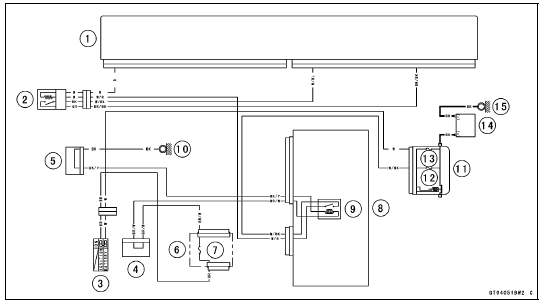
1. ECU
2. Oxygen Sensor
3. Ignition Switch
4. Joint Connector F
5. Joint Connector A
6. Fuse Box 1
7. Ignition Fuse 15 A
8. Relay Box
9. ECU Main Relay
10. Frame Ground 3
11. Starter Relay
12. ECU Fuse 15 A
13. Main Fuse 30 A
14. Battery
15. Engine Ground
 Subthrottle Sensor Resistance Inspection
Subthrottle Sensor Resistance Inspection Exhaust Butterfly Valve Actuator Sensor (Service Code 34)
Exhaust Butterfly Valve Actuator Sensor (Service Code 34)Tail/Brake Light (LED) Removal/Installation
Remove:
Upper Seat Cover (see Seat Cover Removal in the
Frame chapter)
Disconnect the tail/brake light connector [A].
Remove:
Tail/Brake Light Mounting Screws [A]
Bolts [B] and Brackets [C]
Bolt [D]
Remove the tail/brake light [A].
Bring down the rear fender rea ...
Brake Line Bleeding
The brake fluid has a very low compression coefficient so
that almost all the movement of the brake lever or pedal
is transmitted directly to the caliper for braking action. Air,
however, is easily compressed. When air enters the brake
lines, brake lever or pedal movement will be partially used
...
Rear Wheel Rotation Sensor Removal
NOTICE
The wheel rotation sensor should be handled carefully,
never struck sharply, as with a hammer, or allowed
to fall on a hard surface since the wheel rotation
sensor is precision made. Be careful not to get
water or mud on the wheel rotation sensor.
Do not try to disassemble or repair t ...